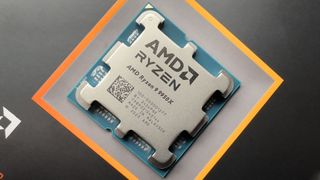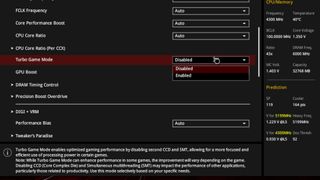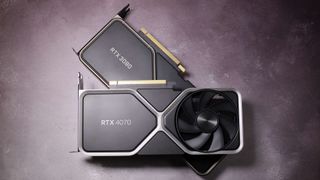I've tested Asus' new Turbo Game Mode for AMD CPUs and my verdict is simple: Don't use it
When worse is supposed to be better but turns out to actually be worse. Or the same. Which is essentially still worse.

We live in some strange times. Let's say you've splashed the cash and bought yourself a brand new Ryzen 9 9950X processor. It's got 16 cores, 32 threads and it's a seriously capable CPU, though not the absolute best for gaming. Well, Asus reckons it has a fix for the latter in the form of a new Turbo Game Mode, that halves the number of cores and quarters the number of threads.
Specifically, what Turbo Game Mode (TGM) does is disable one of the CCDs (Core Complex Dies) and SMT (Simultaneous Multithreading). In short, it turns the likes of the 9950X into an 8-core, 8-thread processor. The idea is that some games just don't like to have threads scattered across separate dies or sharing any cores.

To see if this is the case for any of the games in our CPU benchmarking suite, I ran them afresh with the beta 2505 BIOS for the Asus ROG Crosshair X670E Hero motherboard. The test setup used a Ryzen 9 9950X, 32 GB of DDR5-6000 CL28, a GeForce RTX 4070, and Windows 23H2.
You can see the results for yourself below but as a quick summary, Cyberpunk 2077 and Baldur's Gate 3 ran worse with TGM enabled, Metro Exodus and Total War: Warhammer 3 ran exactly the same as without it, and Homeworld 3 and Factorio ran better with it on.
A mixed bag but when Homeworld 3 only ran 2% better on average, and Factorio 5% quicker, it raises a simple question: Is it worth using it at all?
One thing worth considering is that this is a BIOS option and not something that you can flick on and off while in Windows. TGM absolutely ruins the CPU's content creation capabilities so it's not a setting that you'd ever use in that situation.
And unless you only play a specific collection of games, where TGM does help, you'd get pretty annoyed having to reboot your PC every time you wanted to play something different.
The biggest gaming news, reviews and hardware deals
Keep up to date with the most important stories and the best deals, as picked by the PC Gamer team.
When I first reviewed AMD's dual CCD Zen 5 chips, the Ryzen 9 9900X and 9950X, I noticed that the recommended power settings actually made things worse. AMD stated that one should use the Balanced power profile in the old Control Panel and then Balanced or Best Performance in Windows settings.
This configuration would allow AMD's drivers to activate core parking on the second CCD when a game is detected. In other words, turn the 9950X into an 8-core, 16-thread chip from the perspective of the game. I found that this didn't actually help and the review performance figures were collected using High Performance in the Control Panel (i.e. no core parking).
Mindful of the fact that there have been numerous updates to AMD's drivers, Windows, and AM5 motherboard BIOS files since then, I went back to see if the recommended power profile settings were better.

Best CPU for gaming: The top chips from Intel and AMD.
Best gaming motherboard: The right boards.
Best graphics card: Your perfect pixel-pusher awaits.
Best SSD for gaming: Get into the game ahead of the rest.
Well, they're not, or at the very least, they're not with my configuration—High Performance/Best Performance still produces better results than Balanced/Best Performance, although the gap between them is now a lot smaller than it was originally.
Now, I've only tested five games, which is a tiny sample, and I'm sure there are games out there that would genuinely benefit from Turbo Game Mode being enabled. However, having to jump in and out of the BIOS to switch it is a drag and I can't see many opting to use it regularly if the overall change it brings is zero.
I suppose it's nice to have the option to quickly shut off one CCD and disable SMT by selecting one option, rather than having to delve into the BIOS options and do all that manually, but it's a setting for the very few of us. Everyone else should just leave it alone and enjoy your AMD CPU as AMD intended—chock full of cores, threads, and gaming goodness.

Nick, gaming, and computers all first met in 1981, with the love affair starting on a Sinclair ZX81 in kit form and a book on ZX Basic. He ended up becoming a physics and IT teacher, but by the late 1990s decided it was time to cut his teeth writing for a long defunct UK tech site. He went on to do the same at Madonion, helping to write the help files for 3DMark and PCMark. After a short stint working at Beyond3D.com, Nick joined Futuremark (MadOnion rebranded) full-time, as editor-in-chief for its gaming and hardware section, YouGamers. After the site shutdown, he became an engineering and computing lecturer for many years, but missed the writing bug. Cue four years at TechSpot.com and over 100 long articles on anything and everything. He freely admits to being far too obsessed with GPUs and open world grindy RPGs, but who isn't these days?

Nvidia has reportedly killed production of all RTX 40 GPUs apart from the 4050 and 4060 as affordable 50-series GPUs could arrive earlier than expected

AMD's 2025 laptop plans sure do include a lot of refreshed and rebranded APUs, but who cares when you've got Fire Range, Strix Halo, and four RDNA 4 mobile GPUs heading our way next year
Most Popular







